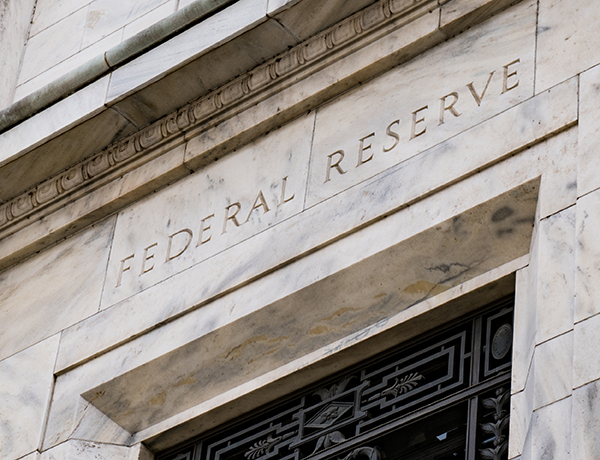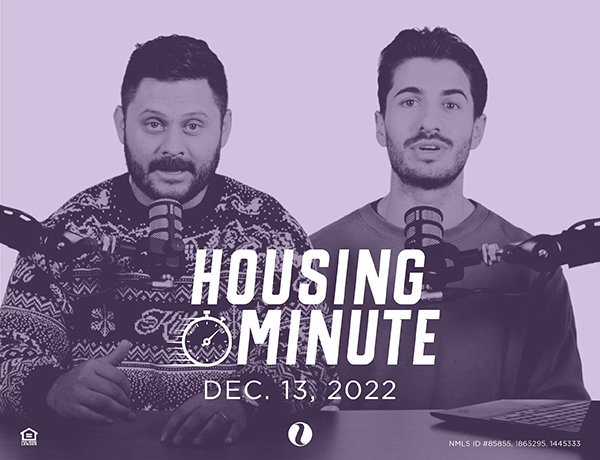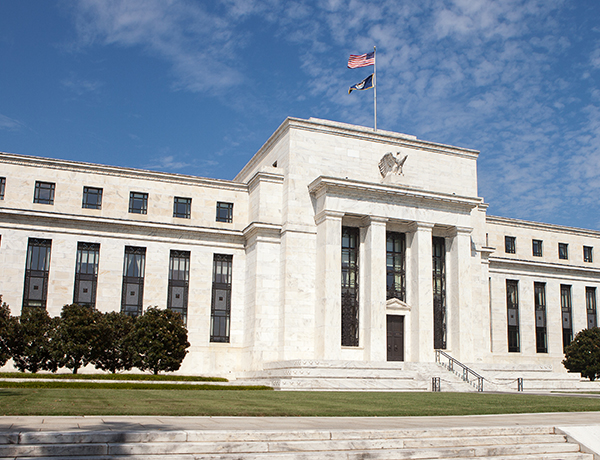Today’s Mortgage Rates December 2022

Dec 29, 2022 – Mortgage bonds accomplished a technical move to the bottom of a trading channel. Hope is that we can now see bond prices move to the top of the range, which would help improve mortgage rates. If you choose to float, do so only if you are able to closely monitor the markets.

3 THINGS TO KNOW
1. Household Formations Are Down
Household Formations have dropped sharply since mortgage rates moved higher in 2022. This isn’t a true reflection of families actually wanting to break out and buy a home, it is a reflection of how many families are willing to purchase at today’s home prices and interest rates. As we see rates come down in 2023, we will see more buyers step back into the market.
With builders slowing the pace of new home starts, this will help stabilize existing home values. When you consider that home values have increased in value an average of 9% in the last 12 months, the housing market has held up better than many expected.
2. Mortgage vs 10 Year
The spread between mortgage rates and 10-Year treasury is starting to narrow. We generally expect average mortgage rates to be around 2% above the yield of the 10 YTN. At the peak, we saw this spread exceed 3%. Even just getting this spread closer to 2% would help move mortgage rates about 3/4% lower. Let’s hope this spread narrows.
3. Jobless Claims Are Still Low
Initial Jobless Claims for last week came in at 225,000. Given that this was the week prior to Christmas, this is a higher number than many anticipated. Since there is a stigma for companies who layoff so close to Christmas, most do all they can to hold off on layoffs until the start of the new year.
Remember, we need to see this weekly number climb to a range near 320,000 per week for the Fed to have accomplished its goal. The labor market is always the last to fall before a recession. We expect to see a much higher number of layoffs as we approach mid-2023.
Dec 28, 2022 – Mortgage rates continue to move higher in what seems to me to be largely a technical move. We will maintain a locking bias while we wait to see if the technicals that should prevent mortgage rates from moving much higher hold.

3 THINGS TO KNOW
1. Home Prices Fall, But Are Still Up Big This Year
According to the Case Shiller Index, home prices fell .5% in the month of October. Although values fell, they are still up 9.2% on a year-over-year basis. It is overall good news to see home values slightly lower, as the rise in home prices during the pandemic was not sustainable and contributed to the significant rise in inflation. Since housing costs make up more than 1/3 of the Consumer Price Index report, the fall in housing costs will help support lower mortgage rates in 2023.
2. Oil Making A Comeback
The concern over higher oil prices is adding renewed fears of an inflation spike. With China loosening its Covid restrictions, we could see a spike in demand for oil, which would add upward pressure to oil prices. Since most goods and services require oil in some form, higher oil prices would increase the costs to run a business which can be added to the price consumers pay for goods and services.
3. Traders Are OOO
In this final trading week of 2022, we can expect to see exaggerated moves in both the stock and bond markets as many traders take the week off. The lack of trading activity could create wild intraday swings that move mortgage rates. Let’s hope the market gains clarity and stability in 2023.
Dec 27, 2022 – Mortgage rates continue to move higher in what seems to me to be largely a technical move. We will maintain a locking bias while we wait to see if the technicals that should prevent mortgage rates from moving much higher hold.

3 THINGS TO KNOW
1. Let’s See If These Hikes Pay Off
Consumer inflation is falling. Friday’s Personal Consumption Expenditures (PCE) report showed that when you exclude volatile food and energy costs, prices rose by .2% in the month of November This brings the annualized rate from 5% down to 4.7%. This is the key metric the Fed uses to set their policy target at an annualized rate of 2%. Although we have a ways to go, inflation is moving in the right direction. We can expect this number to continue to fall in 2023 as the series of hikes continue to take hold in the US economy.
2. One Step Forward, Two Steps Back
A massive spending bill passed the end of last week, further adding stress to an already unhealthy bond market. Not only is excess spending inflationary, bond traders know that the US Treasury will need to sell long-term treasury notes and bonds to help fund the committed spending.
More debt supply in the markets means interest rates will need to increase to attract sufficient demand. Since mortgage bonds compete in the same marketplace for investor money, this translates to upward pressure on mortgage rates.
3. Inflation, Kinda Like Voldemort
We can all agree that the word “inflation” is not a term we hope to hear next year. We’ve all had enough. The terms used in 2023 will likely be recession and slow down. This is expected to be the year where the 4.25% increase to the Fed Funds Rate in 2022 sink in. We can expect weekly jobless claims to rise to the 320,000 level, the unemployment rate moves up to nearly 4.6%, and mortgage rates fall to the 4.5% – 5% level. It is not expected to be a year where wealth flows freely thought out the US.
However, at least it will not be a year where interest rates make multi-decade-high leaps and the US housing market comes to a screeching halt. That was 2022, and it will soon be behind us.
Dec 22, 2022 – There is very little chance rates will improve much, if at all, today. All hope is in tomorrow. Floating today will be risky, but could be rewarded tomorrow. We will see.

3 THINGS TO KNOW
1. Tomorrow is A BIG Deal
This morning’s final report on 3rd quarter GDP showed that the US economy grew at an annualized pace of 3.2%. This is hotter than estimates of 2.9%, which is not welcomed news to the Federal Reserve which has been raising short-term interest rates to help slow down an overheating pace of growth.
Again, the importance of tomorrow’s PCE report can not be understated. Although we expect this to show consumer inflation is quickly falling, there is always a chance for an upward surprise.
2. A Necessary Evil
Job losses in the US remain low, with only 216,000 new unemployment claims filed last week. Given that we are so close to Christmas, we don’t expect to see mass layoffs just during the holiday season. Usually, companies will do what they can to avoid the stigma of cutting staff at this time. Once the new year has passed we anticipate this number to move higher.
Remember that the Fed wants to see the unemployment rate move up to 4.6%, which is well above the current level of 3.7%. To hit the Fed’s target, we need to get to where we are seeing new unemployment claims hit about 325,000 per week. Then the Fed will consider softening its stance and cutting rates. The sooner we get there the better.
3. Markets Feeling Under the Weather
Both the stock and bond markets remain very unhealthy. Stocks are falling sharply already this morning and the bond market has lacked the liquidity to remain stable. We could see both stocks and bonds rally tomorrow if consumer inflation is shown to be tame. Let’s hope tomorrow brings better news.
Dec 20, 2022 – Mortgage rates have continued to move higher. There are now more technical indicators that could indicate more bad news ahead. Unfortunately, we will maintain our locking bias.

3 THINGS TO KNOW
1. Japan is finally feeling inflation
The Bank of Japan shocked markets by doubling a cap on 10-Year yields. Although their yields were held artificially capped at 0.25% prior, the doubling now allows their 10-Year yield to climb to 0.5%. Many economists view this as the beginning phase of an exit to their extraordinary stimulus policy that has held many rates below 0% for years.
This surprise move sent shockwaves through global markets, pushing market interest rates in the US higher and forcing stock markets lower. This move is in response to Japan seemingly overcoming an extended period of deflation, and could signal a longer-term policy change that could one day allow rates to move even higher.
2. Builder confidence is still falling
December marks one full year of declining builder confidence. Unfortunately, this morning’s Housing Starts report shows that new construction slowing continues to deepen. The report showed a month over month decline of 7,000 units. In addition, Housing Permits were down a staggering 170,000 from the month prior. Since the number of permits indicates future starts, this shows how painful higher mortgage rates are to home builders.
Even the recent move lower where rates fell from above 7% to a national average of 6.3% today has done little to support the housing market. Rates are just still too higher to provide hopes for a balanced market. We believe that once we see rates fall below 5% we should see an upturn in homebuyer activity. I hope the Fed is watching and taking note of the destruction these rates are having on the industries related to housing. It almost feels like the Fed is seeking revenge at this point.
3. 2023 is the year
Economists now believe there is a 7 in 10 chance that the US economy will fall into a recession in 2023. Given that mortgage interest rates generally fall in recessionary times, this could help slow the headwinds facing the housing industry. Although 2023 is not expected to be a great year for mortgage lenders, real estate agents and home builders, hopefully softer rates will help things improve from their current state.
Housing Minute
What you need to know in 60 seconds… every Tuesday
Dec 19, 2022 – After failing to break through a critical level in the bond market, mortgage interest rates have bounced higher in the past couple of days. This is a normal move that I would consider to be more of a fundamental move vs one made from supporting data. In the meantime, we will hold our locking views.

3 THINGS TO KNOW
1. Well, that’s unnecessary…
The Federal Reserve is again making the statement: STOP BUYING HOUSES! This message is heard loud and clear in the undertone of comments made by Fed members. Each time rates fall, the Fed is there to remind the markets that they want Americans to feel more and more pain before things can get better. They don’t want to see the housing market resurge and once again have home values rise at unsustainable rates. Their solution is to ensure mortgage rates don’t fall. This is getting old and has been taken way beyond what is needed.
2. The ripple effect of the housing recession
Bidding Wars and No-Contingency contracts were a savagely unhealthy aspect of the US housing market of 2020 – 2021. I completely agree that the Federal Reserve needed to step in to stop these from continuing. Also, the rate of home value appreciation was also unhealthy. However, when you look at the current data, the housing market is in a recession. This is deeply impacting all industries related to housing, including housing sales, builds, and mortgage.
Although home values are not experiencing a dramatic decline overall, the key point will be how well values hold when jobs start to be lost. Generally speaking, the speed of inflation falling escalates quickly as the labor market shrinks.
3. The next recession
With the final reading on 3rd quarter GDP set for release Thursday, it is interesting to note that the Federal Reserve has a target growth rate for the US economy at only .5% in 2023. Considering that this was projected at 4% not long ago, the Fed is quickly coming to the realization that a recession is likely. Although they lack the courage to be straightforward in their beliefs, we should all prepare for what is highly probable to be a recession in 2023.
Dec 16, 2022 – With upward pressure driving interest rates higher, the safe play remains to lock. We need a strong reason for bond prices to rally before we will see mortgage rates take another step lower.

3 THINGS TO KNOW
1. Someone Get A SNICKERS!
Mortgage bonds have some serious HANGER!
They’ve been waking up angry and then calming towards the end of the day. Hopefully, we will see bond prices improve from this morning’s lows as the day wears on. Maybe someone needs a Snickers bar or a cup of coffee.
2. Europe, it’s in Your Hands Now
European bond yields are moving higher, which is also driving interest rates higher here in the US as global money searches for the highest yields. The new higher yields in Europe are looking more attractive as they increase at the same time we have had US Treasury yields move lower. Once Europe is perceived to have contained inflation, we will see yields overseas fall, which will help rates fall here in the US.
3. It’s the Hope that Kills You
It seems that any time mortgage rates have a glimmer of hope of making a move lower, the Federal Reserve steps in to ensure this doesn’t happen. The Fed’s economic projections showed that they expect Core inflation to end 2022 at 4.8%. This is higher than what most economists are projecting, and is causing a ripple effect through both the stock and bond markets, both of which are off to a rough start this morning.
Just yesterday, mortgage rates were at lows matched from early September prior to rates taking a strong jump to multi decade highs. It seems we will now have to wait until the next consumer inflation report on December 23rd to see if there is a case for rates to move lower.
Dec 15, 2022 – Mortgage bonds have battled the current ceiling of resistance for weeks now. Until they are able to muster the strength to overcome this critical level, there is not much hope in rates improving. The general rule is to lock when at the top of a trading channel, which is where we are now. Let’s hope that bonds gain strength as the day wears on and makes another attempt to clear this hurdle.

1. Do You Believe What You Are Saying?
Fed President Jerome Powell continues to lose creditably. Following the ½% rate hike that was 100% expected, he made some comments that showed just how out of touch the Fed is in understanding the math behind their beliefs. The key issue is that the Fed still says we can avoid a recession even though they believe the following:
– The Unemployment Rate will get up to 4.6%
– The Fed Funds Rate will end 2023 at 5.1% and fall to just 4.1% at the end of 2024
– Inflation is falling and the lagging rent component of CPI is yet to show in the already low .2% month-over-month pace of inflation last month
Believe me, if we see the Unemployment Rate hit 4.6%, the Fed will not hold rates as high as they project for as long as they believe. We will see the Fed roll over and trim rates to help prevent further destruction. Further, since the labor market is the one key factors holding the US from truly being in a recession, we would absolutely be in a recession before hitting a 4.6% jobless rate. The Fed is lacking the courage to speak the truth. Or they truly don’t understand, which I have a hard time believing.
2. ‘Higher Rates’ DOES NOT Mean Higher Rates
Yesterday’s rate hike could help soften mortgage rates in the near term. As the Fed continues to drive higher short-term rates, we will likely see interest rates controlled by the market, such as mortgage rates, fall as investors believe inflation levels are falling. Basically, the Fed controls all borrowing rates that are tied to the Prime Lending Rate.
This would be second mortgage loans / home equity loans, car loans, credit cards, and most consumer loans. As these rates continue to increase, we can expect mortgage rates to fall. This should help improve the money flow in real estate and could help bring more sellers and buyers to the market in 2023.
3. Mortgage Rates Could Be Lower
The spread between average mortgage rates and the 10 Year Treasury Note yield is what is holding mortgage rates artificially high. This spread is generally between 1.75% – 2.25%. However, it is now nearly 3%. If this were to fall to a more historic level of say 2%, we would now be quoting mortgage rates in the upper 4% range.
The Fed could help solve the liquidity issues that are keeping mortgage rates higher than they should by simply reducing the pace of their balance sheet reduction. A move like this would help improve both the housing and mortgage markets.
Dec 14, 2022 – We anticipate a volatile day, with the hoped-for outcome rates moving lower. We suggest being prepared to lock in the event the Fed statement causes rates to move higher.

1. Another 50bps
The Federal Reserve will announce a ½% rate hike at 2:00 pm EST today. While this is already baked into the market, the concern will be the statements Fed President Jerome Powell makes after the rate hike is announced. The last time the Fed met and raised rates, mortgage rates initially improved on the announcement only to be driven higher as Powell made his remarks.
Since he has been very clear that the markets need to feel more “pain” before things get better, he may not be happy with the recent improvements to the stock market. His words have tremendous influence over the near-term direction of mortgage rates. We need to listen closely and see how the markets respond.
2. 39% is a BIG Piece
The largest component of the CPI report is shelter costs. This makes up roughly 39% of the total and was again shown to be a rising force in yesterday’s recent report. This component is falling, but it generally lags in the CPI report. Yesterday’s report showed an increase over the prior month.
However, we all see the significant softening the housing and rental markets are experiencing. Beginning in January, we will see weaker data, which will help drive overall inflation even lower. That is good news for our economy as well as for mortgage rates in 2023.
3. Homebuyers, 2023 is Your Year
Homebuyers who missed the low interest rates of 2021 could make a strong comeback in 2023. With home prices softening, and sellers more willing to negotiate on terms, closing costs and price, many will be in a stronger position to buy than if they had made the move last year.
If you have buyers on the fence, now is the time to start getting them prepared to make the move. Once rates fall below 5%, we expect to see more homes being listed and more buyers wanting to buy. If you have buyers who want a report that will show them the benefits to buy in 2023, we would be happy to help.
Dec 13, 2022 – Mortgage rates have improved on the news of lower inflation. However, investors will not likely take too much risk ahead of tomorrow’s Fed announcement. The risk of floating today is elevated. Hopefully, we will see a stronger improvement tomorrow.

1. Wow, That Feels Good
The Consumer Price Index showed that inflation continues to fall. The Headline number reported an increase of just .1% in the month of November, which is lower than the market’s expectations of a .3%. When you strip out volatile food and energy prices, the Core rate grew at a rate of .2%, which is also below expectations of .3%.
Since the Fed can’t do anything to impact food or energy prices, they use the Core rate when setting the target rate of 2%. At this point, the annual rate of Core inflation is at 6%. Although we have a ways to go, we are certainly on the right track.
2. This Time It’s Different…
What many people who have expected inflation to rise to 10% don’t seem to understand is that this inflationary cycle is much different than prior cycles. Inflation is driven by two sides. The first side is the demand side, which the Fed can control by increasing rates. The second is the supply of goods, which the Fed has no control over. The supply of goods was greatly restricted by Covid lockdowns and a massive drop in worker productivity as employers sent employees home to work (and for some watch Netflix 😊).
As supply chains catch up, we are seeing downward price pressure as consumers are now able to purchase the goods and services that they desperately wanted but were unable to get. The good news is that both supply pressures and demand pressures are working to push inflation lower, which will help drive mortgage rates lower in 2023.
3. The Last Domino is Jobs
The Federal Reserve is set to announce a ½% increase tomorrow. Now that they have two months of slowing inflation data, we can expect their comments to soften. The final piece of the longer-term issue is the labor market. The US workforce has lost many workers that chose not to return after being sent home during the pandemic. This has significantly impacted working moms as well as the older population.
With fewer workers available to meet the demand of US consumers, average worker pay has increased at unsustainable rates. We either need more workers to reenter the labor force or we need consumers to be more restricted in their ability to make purchases. The way the Fed accomplishes the latter is by making the cost of financing purchases higher, which will deter some from buying cars, houses, and other goods that people generally finance.
Dec 12, 2022 – In the near term, there is a great risk of floating. Our hope is that tomorrow’s Consumer Price Index report is favorable and that there are no surprises to the Fed announcement on Wednesday. If so, we could see rates fall.

3 THINGS TO KNOW
1. Homes AREN’T Dead
Although the housing market is in a recession, this doesn’t mean prices are crashing. The Housing Recession of 2022 was created by a mortgage rate lockdown, which is far different than the credit bubble collapse of 2008. Prior to the Great Recession of 2008, we saw signs of the mortgage market collapse that led to high levels of foreclosure and a subsequent drop in home values across the country.
This is not the case today. Home equity is strong, consumer balance sheets are strong and the quality of mortgage credit that underwrote the debts is strong. Contrary to what many taking heads on financial news stations and Instagram are saying, we are not going to face a dire housing market in 2023.
2. Increasing Rates ≠ Increasing Rates
With the Fed set to raise the Fed Funds Rate by ½% on Wednesday, this does not mean that mortgage rates will move higher. Similar to stock prices, mortgage rates are driven by the market. Before the Fed’s first rate hike of 2022, mortgage rates had already moved more than 1% above where they started the year.
By the time we hit October of 2022, mortgage rates had already experienced nearly a 4% increase. Now that the Fed is catching up, we are seeing mortgage rates start to fall. If the market believes that inflation is now on a downward trend, mortgage interest rates will continue to drop, even if the Fed continues to hike.
3. A Forever Home
People are keeping their homes longer than before, adding to the market’s lack of available housing inventory. This trend has been in place since the housing market recovery began in 2013 and is likely a response to tighter mortgage standards implemented after the housing crash. When mortgage lending allowed people to purchase homes well beyond their comfortable long-term payment level, mass numbers of homeowners sold their houses and upgraded their living arrangements.
Lots of these buyers used growing home equity to extend their time in the new home. When values fell and mortgage standards tightened, they were again forced to move. This helped shorten the documented lifespan of a residence timeline down to below an average of 7 years. Now that we are in a more normal lending environment, people are remaining in their homes longer; in many cases, much longer.
Dec 9, 2022 – 3 THINGS TO KNOW

1. Rates are holding us hostage
The US housing recession continues as homeowners are held hostage by their 2-3% interest rates. Since falling more than 1% over the past few weeks, lower mortgage rates have more owners considering listing their homes and making a move. If rates continue to fall, we could see a more balanced market by mid-2023. I would expect this to look more like the markets of 2018 – 2019, which is much better than some of the doom and gloom predictions floating around on social media.
2. Good, but not good enough
Producer Price Index (PPI), which measures inflation on the wholesale level, fell on an annualized basis from 8.1% to 7.4%. Although this is a significant year-over-year decline, the market expected the annualized rate to fall to 7.2%. With PPI considered a precursor to Tuesday’s Consumer Price Index (CPI) report, today’s hotter-than-anticipated report has markets concerned that we will see inflation on the consumer level not falling as quickly as they have priced into the market. As a result, we are seeing upward pressure on mortgage rates.
3. Reports to remember
I can’t underestimate the importance of next week’s Consumer Price Index report on Tuesday and the Fed rate announcement on Wednesday. These two reports will heavily influence the short and medium-term outlook for mortgage rates, which will strongly influence how the US housing market performs in 2023. Although many believe real estate is an asset that should benefit from high inflation, homes are meant for shelter, not as an investment. The buyers who need a mortgage are buying a payment, not a home. The home they can purchase is a direct reflection of the payment they can either afford or desire. This is why we see home values climb higher in deflationary periods when mortgage rates are low.
Dec 8, 2022 – In the near term, there is little hope of rates improving. The best opportunities will be after Tuesday’s CPI report and Wednesday’s Fed announcement is behind us.

3 THINGS TO KNOW
1. The dollar is weakening
As the dollar was strengthening throughout most of 2022, this forced other countries that held US debt to sell massive blocks of US treasuries to help add strength to their own currencies. This move helped contribute to the rapid increase we saw in mortgage interest rates. With the US dollar weakening, we are seeing treasuries now being purchased. As more buyers step in to purchase treasuries, we will see interest rates continue to fall.
2. Rates at 8-10%??
Recent drops in rates have splashed water on the groups who believe mortgage interest rates are heading to 8% – 10%. The only real way this camp of people could be right is to assume the US economy will massively boom, that inflation will reach higher levels than we have seen in recent months and that inflation will remain high for a very long time. It is becoming clearer that inflation is heading lower, as asset and commodity prices fall.
3. Mortgage rate dip
As we prepare for next Wednesday’s Fed rate hike, bondholders are reducing their risk of holdings. This is adding short-term upward pressure on mortgage interest rates today. We can expect rate volatility to increase between now and Wednesday. After the Fed announcement, bond investors will be more willing to increase their financial risks. We could see mortgage rates take a nice dip in the coming weeks and months. I believe that once mortgage rates fall into the upper 4’s, this will unleash a rush of buyers to the market.
Dec 7, 2022 – Until we know what the CPI report shows, there is great risk in floating in the near term. Float only if you have time to wait to lock until next week and if you are willing to take the risk.

3 THINGS TO KNOW
1. Employee productivity and inflation
Employee productivity during the pandemic plummeted as employees vacated their offices and worked from home. Although many employees loved the convenience, productivity reports showed that workers accomplished far less from home than they do in the office. Given that lower productivity is a major driver of inflation, working from home contributed to the inflationary issues we have been battling. Now that most employees are back in the office, we are seeing productivity levels improve. Q3 had a productivity improvement of 0.8%, which is much better than the -4.1% loss we saw in Q2..
2. The Netflix dilemma
Speaking of productivity, one interesting fact is that streaming sites such as Netflix saw a major shift in viewing times. Prior to Covid, Friday and Saturday nights were when viewer numbers spiked. However, once people went home to work, the weekday hours after noon became the most popular. Clearly, this was driven by work-from-home viewers enjoying their shows while they worked, or as Elon Musk put it, pretending to work 😊
3. Bonds, bonds, bonds
The bond market remains in a critical battle, with yields on the 10-Year Treasury Note trying to break beneath their 100-Day moving average. A decisive break beneath this level would be very good news for mortgage interest rates, as improvements in the 10-Year would help drive mortgage interest rates lower. Although I don’t anticipate this to happen prior to Tuesday’s Consumer Price Index report, even the prospect of this happening is something to celebrate.
Dec 6, 2022 –The bond market continues to battle significant levels. As of this moment, they are holding. Should the battle be lost, we will see rates tick a bit higher. Float if you are able to closely watch the markets, but be prepared to lock should bond prices suddenly fall.

3 THINGS TO KNOW
1. Equity protects from a recession.
The US economy continues to show mixed signals as we head into 2023. With most experts now anticipating a recession, it seems the contrarian view would now be tilting towards the likelihood of a soft-landing.
Strong personal balance sheets now boosted by many homeowners having access to large amounts of reserves from taking out home equity lines of credit against their equity-rich homes could help shelter many from the risks of job loss. This will lessen the impact of a recession on many families who face job loss, and should be something all homeowners consider as a solution to boost cash reserves.
2. Shipping is a problem.
Regardless of if or when the US does fall into a recession, it is clear that consumer demand is softening. Recent data shows that US manufacturing orders in China are down 40%. This has creating a major problem for the shipping industry that up until recently has had significant demand that led to a spike in the cost of goods being transported by sea.
The slowing demand is helping to reduce inflation, which will also contribute to softer mortgage interest rates as we head into the new year.
3. Next week is important for inflation.
Next week will be significant for the future direction of mortgage interest rates. One week from today we will get an update on the pace of consumer inflation when the Consumer Price Index (CPI) report is released. Then on Wednesday, the Federal Reserve is expected to raise short term interest rates by ½%, in what is considered to be the first step towards a “Fed Pause.”
This is assuming the CPI print isn’t an upward surprise, but falls in-line with the market’s expectation. If inflation is shown to be running hotter than anticipated, the Fed could decide to maintain their ¾% hiking pace. However, it seems more likely we will see inflation cooling.
Dec 5, 2022 – 10-Year Treasury Note yields have bounced off a critical floor and are now moving higher. This is adding upward pressure to mortgage interest rates. With mortgage rates currently moving higher, we will suggest a locking bias.

November Job’s Report Breakdown
After having more time to analyze Friday’s strong Bureau of Labor Statistics (BLS) report, it is clear there are some misleading numbers hidden in the report.
Of the 263k new jobs reported in the month of November, 165k of these were created by multiple job holders, which is common for a November report to account for holiday seasonal jobs. Further, the birth/death modeling used to come up with November’s number has an estimated 110,000 new hires. Between workers taking on a second income source and the birth/death modeling estimates, we have more than accounted for the total number of new job creations reported.
One other key point to consider is that employers generally cut back worker hours prior to enacting layoffs. Total worker hours were cut back by .3% last month, which would equate to approximately 380,000 jobs. If market conditions don’t improve, many of the employers who cut back on worker hours will eventually make the difficult decision to layoff.
Mortgage interest rate volatility has once again been an issue over the past few days. We have had multiple days where we have had same-day swings of ¼%. This is not typical for the mortgage market but has undoubtedly been a key factor in 2022. Without the support of the Federal Reserve, mortgage bond pricing has lacked stability, making opportunities to secure a rate more confusing and has added pressure to make fast decisions on locking before the opportunities pass. The key lesson is to be prepared to lock when rates fall, as the market can shift quickly.
Dec 1, 2022 – For those with the stomach to float, you may be rewarded with better pricing tomorrow. However, realize there is a great risk, as the labor market has shown significant resilience, even in this rising rate environment.

More good news for mortgage interest rates as Fed President Jerome Powell had a softer tone on inflation in his speech yesterday.
I’m wondering if he had a sneak peek at the Personal Consumption Expenditures (PCE) report that was released to the public this morning that showed consumer inflation is in fact cooling.
The Core PCE, which removes volatile food and energy prices, grew at a .2% rate last month. This is a very reasonable monthly gain and shows the Fed’s progress in its battle to fight inflation. Although it will take many months of low reports to bring the annualized pace down from its current level of 5.2% down to the 2% Fed target, this is certainly a step in the right direction.
One key point is the Federal Reserve does not directly control mortgage interest rates. In fact, mortgage rates can even fall as the Federal Reserve continues to drive the Fed Funds Rate higher.
Mortgage rates follow inflation up or down, regardless of what the Fed chooses to do. With the next big read on inflation coming December 13th when the Consumer Price Index for November is released, that will help provide more insight on the longer-term direction of mortgage interest rates.
Tomorrow morning, we will hear from the Bureau of Labor Statistics (BLS) about how many jobs were created in the month of November. In a slowing economy, jobs are generally the last to go before heading into a recession. We all know that the Fed is pushing to move the Unemployment Rate higher by hiking interest rates. A major slowdown in the pace of job creations would indicate that they are succeeding in their efforts. A low number will be good for mortgage rates.



